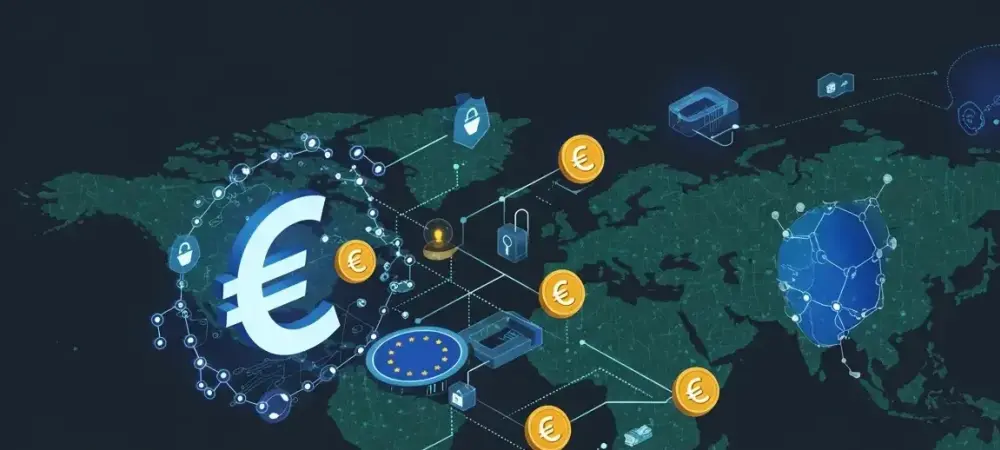In an increasingly globalized economy where digital payments and blockchain technologies redefine financial transactions, one trend gaining momentum is the rise of euro-backed stablecoins across Europe. These digital assets leverage blockchain’s transparency and security while maintaining price stability, pegged to the euro—a significant move for the region. These innovations have the potential to transform consumer and business interactions, making transactions more efficient and less risky. With Europe as a pioneer in adopting these stablecoins, this trend deserves attention as it becomes integral to digital finance. Our discussion will examine growth and adoption, practical implementations by prominent entities, expert insights, and future prospects.
The Growth of Euro-Backed Stablecoins
Expansion and Adoption in Europe
The proliferation of euro-backed stablecoins in Europe signifies an essential shift in the digital currency landscape. Recent reports highlight a substantial increase in stablecoin activities, emphasizing their growing presence among consumers and businesses as both parties gravitate toward euro-denominated digital assets. This rise is facilitated by several factors, including a robust regulatory framework, increasing vendor acceptance, and the need to mitigate currency exchange risks that have historically been associated with dollar-based stablecoins. As euro-backed stablecoins gain traction, they offer a reliable alternative for users seeking stability and transparency in digital transactions.
Practical Use and Implementation
Real-world adoption of euro-backed stablecoins is notably led by companies such as Wirex and Schuman Financial, which have successfully integrated these digital assets into their operations. Wirex’s partnership with Schuman Financial introduced EURØP, a euro-backed stablecoin designed to enhance transactions via the Wirex App. This initiative allows millions of users to buy, hold, and spend EURØP alongside traditional currencies. Additionally, the stability of EURØP is ensured by being issued through a regulated French institution, supporting daily transactions and broadening digital commerce opportunities. Such practical implementations demonstrate how euro-backed stablecoins are effectively bridging traditional finance and blockchain technologies.
Expert Perspectives and Industry Challenges
Insights from Industry Leaders
Leading financial analysts and industry experts underscore the importance of euro-backed stablecoins in reshaping the European financial ecosystem. These stablecoins provide a welcome alternative to dollar-pegged counterparts, alleviating exchange rate volatility and promoting more seamless euro transactions. However, experts also warn of inherent challenges, including regulatory oversight, user trust, and technological adaptation required to facilitate widespread adoption. As more companies explore these digital assets, experts predict a substantial impact on market dynamics and the potential for transformative innovation across financial sectors.
Regulation and Technological Adaptation
While euro-backed stablecoins herald promising developments, their widespread adoption comes with hurdles related to regulation and compliance. Ensuring consistency in regulatory practices across Europe is critical for fostering stablecoin growth and user confidence. Moreover, the technological adaptation required to support the vast infrastructure changes that stablecoins bring is significant. As businesses and consumers navigate these technological shifts, industry perspectives are crucial to understanding both opportunities and constraints inherent in this evolving landscape.
Prospects for Euro-Backed Stablecoins
Innovation and Future Developments
Looking ahead, euro-backed stablecoins appear poised for continuous evolution and innovation. The technology and security underpinning these digital assets will likely see advancements, contributing to increased efficiency and broader acceptance. However, successful expansion requires overcoming regulatory obstacles and boosting consumer trust, which could be pivotal in mainstreaming stablecoins across Europe. Future advancements may also ring in new functionalities beyond payments—such as treasury operations—could redefine traditional finance paradigms.
Expansion Opportunities and Regulatory Scenarios
Anticipated regulatory progress and innovation could catalyze further expansion of euro-backed stablecoins, potentially impacting the broader financial ecosystem. Increased user trust through enhanced compliance measures could pave the way for more comprehensive stablecoin adoption. Additionally, engagement with regulatory authorities might facilitate a structured framework for stablecoin operations, ensuring these financial tools function inclusively and effectively. As market participants explore these pathways, understanding future implications remains crucial for those invested in digital finance.
Summary of Key Findings
The emergence of euro-backed stablecoins presents an unprecedented opportunity for reimagining Europe’s position in digital finance. These digital assets provide a vital bridge between traditional currency stability and the transparency of blockchain. As adoption gains momentum, euro-backed stablecoins redefine transactional security and efficiency. The implications for consumers and businesses are vast, offering new avenues for growth and integration. An alert financial ecosystem will embrace these changes, continually adapting to shifts sparked by technological advancements and regulatory considerations. Staying attuned to these developments will ensure stakeholders make informed, strategic decisions in a rapidly changing digital world.

